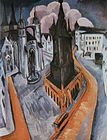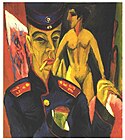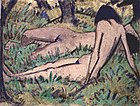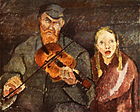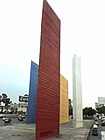- Sandbox for Expressionism
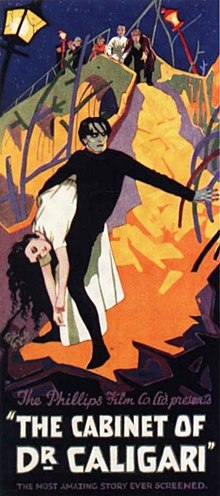
Expressionism was a international modernist avant-garde movement in the arts that originated in Germany at the beginning of the 20th century. [1] As promoted by its many manifestoes, reviews, and books, Expressionism was one of the most self-conscious movements in the history of the arts. [2] The term covers diverse groupings of artists, writers, film-makers, and others and it includes work made in a broad range of art forms, from painting and sculpture, literature and poetry, to theatre, dance, cinema, architecture, and music. [3] No group of painters explicitly called itself "Expressionist" and some writers resisted the term, though it was adopted by artists and writers working in other media, from theatre, film, poetry, etc... get the citations for which exactly. [4] It has been applied retrospectively to significant precursors from the 19th century, such as the plays of Georg Büchner, August Strindberg, and Frank Wedekind and the paintings of Vincent van Gogh and Edvard Munch. [5] The movement is best known for its cinematic masterpieces, The Cabinet of Dr. Caligari (1920), Nosferatu (1922), The Last Laugh (1924), and Metropolis (1927). [6]
Expressionism sprang from intense feelings of dissatisfaction with German society among the younger generation and it proclaimed itself to be a "new art" that would inaugurate a "new life". [7] Thanks to its rapid development in the last decades of the 19th century, Germany became an industrial-economic world power. [8] Expressionism responded to the increasing alienation and mechanisation of life that this capitalist industrialisation and urbanisation brought. [9] Unlike the Symbolists' retreat from this new world, Expressionism confronted its realities with a critical attitude. [10] It was hostile towards the instrumental rationality of science, industrial and technical modernisation, and positivist thought and it rejected 'scientific' approaches to art (such as Naturalism and Pointillism). [11] Instead, it championed subjective expression, individual vision, and rebellion against the values and institutions of bourgeois society and its culture. [12] It often used distortion, the grotesque, and primitivist features to express the experience of modernity. [13] Its "famous cries and shrieks", Douglas Kellner argues, "represent the cries of the individual subject facing repression and threats to its autonomy, inner life, and values." [14]
Expressionism reacted against Realism and Naturalism in the arts. [15] Rather than attempting an objective representation of the surface appearance of external reality, it offered a subjective expression of feeling and imagination and a vision of the world distorted by intense moods, ideas, and emotions. [16] Expressionist writing presents a monodramatic view of the world as seen through the eyes of one character, who is often an alter ego for the author. [17] Expressionism often sought to replicate the formal, associative logic of dreams and depicted puppet-like characters in autonomised, trance-like states who are subject to hostile forces beyond their comprehension or control. [18] Its recurrent themes concerned the erruption of violent, irrational, and chaotic forces from beneath the rigid, reified surface of modern society, the transgression of taboos (especially sexual taboos), and class and inter-generational conflict (particularly with an authoritarian father figure). [19] The image of a recalcitrant or hostile machine (embodied in an automaton, robot, cyborg, or golem figure) expressed its suspicion and fear of technology. [20] The devastations of imperialist warfare reinforced and extended the early Expressionist visions—the something metropolis foreshadowed the battlefields of the First World War and its mechanised slaughter appeared to be a horrifying extension of capitalist production—and prompted a greater degree of social commitment in the movement. [21]
Beginning in the first decade of the 20th century, Expressionism established itself as a major movement during the early Weimar Republic and was still a significant force in the cinema in the later 1920s. [22] After the war, it developed both a utopian activist strand with a more optimistic, humanitarian rhetoric and another, more sober and sceptical strand, which was developed by writers and artists who had experienced the front. [23] When its optimistic, fraternal sentiments were seen to have failed to cope with the rise of the Right, German artistic culture experienced a "sobering up" and moved towards a greater realism. [24] This became known as the Neue Sachlichkeit ("New Sobriety" or "New Objectivity") movement in Germany in the 1920s, which explicitly opposed itself to Expressionism. [25]
Origin of the term

The precise origin of "Expressionism" as a term is uncertain. [26] At first, in 1911, various writers and critics in Germany (including Wilhelm Worringer) used it to describe the post-impressionist modern art by French painters that is more usually called Fauvism or Cubism. [27] It was in this sense that Herwarth Walden used it in March 1912 at the first exhibition at his Sturm-Galerie in Berlin. [28] In his magazine Der Sturm, he extended its scope to the modernist avant-garde in general. [29] Kurt Hiller appears to have been the first to apply it to German literature, in July 1911. [30] Paul Fechter's 1914 book Der Expressionismus (the first monograph on the subject) limited its definition to German avant-garde artists who were reacting against Impressionism and he placed it alongside other national movements, such as French Cubism and Italian Futurism. [31] The painters identified in this way, however, tended to avoid using the word and few writers adopted the term before early 1915. [32] "Looking back to the early days," Richard Sheppard explains, "Expressionists often stress that early Expressionism was not a collectively held ideology, but simply the interaction of independently creative individuals." [33] That the movement existed without "a clear, conscious forumulation of tasks and ends," Fechter argued, "testified to its inner necessity." [34]
Architecture
In architecture, two buildings are identified as Expressionist: Bruno Taut's Glass Pavilion at the Cologne Werkbund Exhibition (1914) and Erich Mendelsohn's Einstein Tower in Potsdam, Germany (completed in 1921). The interior of Hans Poelzig's Berlin theatre, the Grosse Schauspielhaus, which was designed for the director Max Reinhardt, is also sometimes identified as Expressionist. The influential architectural critic and historian Sigfried Giedion dismissed Expressionist architecture as a side-show in the development of functionalism. [35] In Mexico in 1953, German émigré Mathias Goeritz published the "Emotional Architecture" (Arquitectura Emocional) manifesto, in which he argued that "architecture's principal function is emotion." [36] Modern Mexican architect Luis Barragán adopted the term to describe his own work. The two of them collaborated on the project Torres de Satélite (1957–58), in which they implemented the principles of Emotional Architecture. It was only in the 1970s that Expressionism in architecture came to be re-evaluated in a more positive light.
Cinema
Mainly in terms of its subject matter, but also in some aspects of its visual style, Stellan Rye and Paul Wegener's influential Faustian Autorenfilm The Student of Prague (1913) anticipated post-war cinematic Expressionism. [37] Under the impetus of government sponsorship, German film production accelerated during the First World War, a trend that culminated in the creation of Ufa in December 1917, when most of the industry was merged into a state-subsidised conglomerate that was equipped with the best studio facilities in Europe. [38] Erich Pommer, who led one of the companies that remained independent, produced the first Expressionist film, Robert Wiene's The Cabinet of Dr. Caligari (1920). [39]
in which the director of a lunatic asylum (Caligari) compels an inmate (Caesare) to commit murder on his behalf. [40] The Expressionist artists Walter Reimann, Walter Röhrig, and the scenic designer Hermann Warm designed its sets, which externalised the narrator's disturbed subjective state in the film's mise en scène as distorted perpendiculars, exaggerated dimensions, and the stylised, painted representation of light and shade. [41] In 1947, the theorist Siegfried Kracauer blamed the film for conditioning its audience towards Nazism. [42]
used distorting mirrors, unfocused lenses, and superimpositions to create an Expressionist " subjective camera" (an idea conceived by its screenwriter, Carl Mayer) that represented the protagonist's experience of the events. [43] The film communicated its story in an almost exclusively visual manner, with a single intertitle to explain the plot's deus ex machina. [44] It was the last of the German Kammerspielfilme, which were a cinematic form of chamber play whose more realistic treatment of morbid themes and lower bourgeois life both extended and reacted against Expressionism. [45]
The most important examples of German Expressionism in the cinema are Robert Wiene's The Cabinet of Dr. Caligari (1920), Paul Wegener's The Golem: How He Came Into the World (1920), Fritz Lang's Metropolis (1927) and M (1931), and F. W. Murnau's Nosferatu, a Symphony of Horror (1922) and The Last Laugh (1924). [46] Expressionist films employed special effects that distorted something like reality and bizarre sets, costumes, and makeup. [47] Their plots often explored the alienating experience of life in the modern metropolis and insights that are recognised by an unstable or deranged mind. [48] The first Expressionist films made up for a lack of lavish budgets by using wildly non-Naturalistic, geometrically absurd sets, along with designs painted on walls and floors to represent lights, shadows, and objects.

Lotte Eisner argues in The Haunted Screen that German Expressionist cinema is a visual manifestation of Romantic ideals. She examines its staging, cinematography, acting, scenarios, and other cinematic elements in films by Pabst, Lubitsch, Lang (her obvious favourite), Riefenstahl, Harbou, and Murnau. Other film studies scholars have situated the movement within its social, cultural, and economic-industrial contexts, including its relationship to inflation, UFA, Erich Pommer, Nordisk, and Hollywood.
The extreme non-Naturalism of Expressionism was short-lived, fading away after only a few years, yet it has had a profound influence on modern cinema. A good example of this may be found in the career of Alfred Hitchcock. In 1924, Hitchcock was sent by his film company to work as an assistant director and art director at the UFA Babelsberg Studios in Berlin on the film The Blackguard. [49] An immediate effect of the working environment there can be seen in his expressionistic set designs for the film. On returning to England, he made The Lodger, an important silent film in which Expressionism's influence is readily apparent in its set designs, lighting techniques, and trick camera work (such as the image of a man walking across a glass floor shot from below, a concept representing the sound of someone pacing upstairs). [49] German Expressionism's dark, moody aesthetic was transplanted to America when the Nazis gained power and a number of German filmmakers emigrated to Hollywood. These German directors found American movie studios willing to embrace them and several German directors and cameramen flourished there, producing a repertoire of Hollywood films that had a profound effect on film as a whole. [50] Two genres that were especially influenced by Expressionism are horror film and film noir. [51] German filmmakers such as Karl Freund (the cinematographer for Dracula in 1931) set the style and mood of the Universal monster movies of the 1930s with their dark and artistically designed sets, providing a model for later generations of horror films. Directors such as Fritz Lang, Billy Wilder, Otto Preminger, Alfred Hitchcock, Orson Welles, Carol Reed and Michael Curtiz introduced the Expressionist style to crime dramas of the 1940s, expanding Expressionism's influence on modern film-making.
Dance

Expressionism in dance ( German: Ausdruckstanz, also translated as "expressive dance") rejected the conventions of classical ballet and the focus on movement understood by means of static positions, in favour of a new emphasis on movement as a process of change (understood via metaphors of natural, organic growth) and intentional human action. [52] It understood dance as a means for both self-fulfillment and social reform. [53] Exponents of Expressionist dance included Mary Wigman, Rudolf von Laban, and Kurt Jooss. Laban argued for the ability of dance to apprehend aspects of reality and experience inaccessible to the other arts: "Dance expresses things which cannot, or cannot as fully, be expressed by word, drama, or even music." [54] Wigman argued for the autonomy and specificity of dance as a creative activity distinct from the interpretation of music; the material of dance, she argued, is human movement. [55] In 1926, the painter Ernst Ludwig Kirchner frequently visited Wigman's dance school in Dresden, where he made sketches of her Dance of Death. [56] Kirchner argued that Wigman's dance sought to embody a modern concept of beauty that was closely related to that attempted in his own work: "there are parallels," he wrote, "in the movement of the volumes, in which the solitary movement is strengthened through repetition." [57]
Literature and poetry
| “ | At least, those aesthetes who know only how to react, who are nothing more than wax-tablets for impressions, or delicately exact recording machines really do seem to us to be inferior beings. We are Expressionists." | ” |
| — Kurt Hiller, Heidelberger Zeitung (July 1911). [58] | ||
Expressionist poetry flourished in the early 20th century, mainly in the German-speaking countries. The most influential Expressionist poets were Georg Trakl, Georg Heym, Ernst Stadler, Gottfried Benn, and August Stramm. [59] Their experiments in lyric poetry were a prominent influence on the English poetic movement Vorticism. [60] In literature, the novels of Franz Kafka, with their nightmarish visions of labyrinthine bureaucracy, are the nearest equivalent to Expressionism, though the categorisation of his works as belonging to the movement is a contested issue. [61]
Two major literary magazines promoted Expressionist literature in Germany: Der Sturm and Die Aktion. [62] During the First World War, Die Aktion served as a vehicle for the expression of anti-war sentiments. [63]
Music
In music, Arnold Schoenberg, Anton Webern and Alban Berg, the members of the Second Viennese School, wrote pieces described as Expressionist (Schoenberg also made Expressionist paintings). Other composers who followed them, such as Ernst Krenek, are often considered as a part of the Expressionist movement in music. What distinguished these composers from their contemporaries (such as Maurice Ravel, George Gershwin and Igor Stravinsky) is that Expressionist composers used atonality self-consciously to free their work from traditional tonality. They also sought to express the subconscious, the 'inner necessity' and suffering through their highly dissonant musical language. Erwartung and Die Glückliche Hand, by Schoenberg, and Wozzeck, an opera by Alban Berg (based on the play Woyzeck by Georg Büchner), are examples of Expressionist works.
Painting

Two groups of artists are associated with German Expressionism in the visual arts: Die Brücke ("The Bridge"), a Dresden-based group that existed between 1905 and 1913, and Der Blaue Reiter ("The Blue Rider"), which was the name of an almanac that was published only once, in 1912, around which a group in Munich gathered. [64] Others who fall outside these informal groupings are also associated with Expressionism, such as the painter and playwright Oskar Kokoschka in Vienna. [65]
When Die Brücke formed in 1905, all of its members— Ernst Ludwig Kirchner, Erich Heckel, Karl Schmidt-Rottluff, and Fritz Bleyl—were architecture students. [66] Others joined later, including Emil Nolde, Max Pechstein, and Otto Müller. [67] The First World War was responsible for the group's dispersal. [68]
The Expressionists had many influences, among them Edvard Munch, Vincent van Gogh, and African art. [69] They were also aware of the work being done by the Fauves in Paris. [70] Under their influence, Expressionism worked with arbitrary colors and jarring compositions. In reaction and opposition to French Impressionism, which focused on rendering the sheer visual appearance of objects, Expressionist artists sought to portray emotions and subjective interpretations. It was not important to reproduce an aesthetically pleasing impression of the artistic subject matter, they felt, but rather to capture vivid emotional reactions through powerful colours and dynamic compositions. Kandinsky, the leader of Der Blaue Reiter, took this a step further. He believed that with simple colours and shapes the spectator could perceive the moods and feelings in the paintings, a theory that encouraged him to move towards an increased abstraction.

Another prominent artist who came from the German Expressionist "school" was Bremen-born Wolfgang Degenhardt. After working as a commercial artist in Bremen, he migrated to Australia in 1954 and became quite prominent and sought after in the Hunter Valley region. His paintings captured the spirit of Australian and world issues but presented them in a way which was true to his German Expressionist roots.
The ideas of German expressionism influenced the work of American artist Marsden Hartley, who met Kandinsky in Germany in 1913. [71] In late 1939, at the beginning of World War II, New York welcomed a great number of leading European artists. After the war, Expressionism influenced many young American artists. Norris Embry (1921–1981) studied with Oskar Kokoschka in 1947 and over the next 43 years produced a large body of work grounded in the Expressionist tradition. He has been called "the first American German Expressionist." Other American artists of the late 20th and early 21st century have developed distinct movements that are generally considered part of Expressionism. Abstract Expressionism and American Figurative Expressionism were an integral part of American modernism. [72] In Boston, major Figurative Expressionists included Karl Zerbe, Hyman Bloom, Jack Levine, David Aronson, and Philip Guston. These painters were increasingly marginalized by the development of Abstract Expressionism centered in New York City. Figurative Expressionism influenced many artists and other movements, however—Thomas B. Hess argues that "the 'New figurative painting' which some have been expecting as a reaction against Abstract Expressionism was implicit in it at the start, and is one of its most lineal continuities." [73]
Sculpture
Some sculptors were also part of the Expressionist movement, as for example Ernst Barlach. Other Expressionist artists mainly known as painters, such as Erich Heckel, also worked in sculptural media.
Theatre

Georg Kaiser and Ernst Toller are the most famous playwrights of the Expressionist movement in the German theatre of the early 20th-century. [74] Other notable Expressionist dramatists include Reinhard Sorge, Walter Hasenclever, Hans Henny Jahnn, and Arnolt Bronnen. They looked to Swedish playwright August Strindberg and German actor and dramatist Frank Wedekind as precursors of their dramaturgical experiments and the exploration of their subject-matter. [75] In the 1920s, Expressionism became popular in the American theatre, inaugurated by plays such as Eugene O'Neill's The Emperor Jones (1920), The Hairy Ape (1922), and The Great God Brown (1926), Elmer Rice's The Adding Machine (1923), Sophie Treadwell's Machinal (1928), and George S. Kaufman and Marc Connelly's Beggar on Horseback (1924). [76] The American Expressionist plays tend to be more theatrically viable than their German counterparts. [77] The Irish playwright Seán O'Casey also used its dramatic techniques in his play The Silver Tassie (1929). [78] After the Second World War, the German playwright Wolfgang Borchert wrote The Man Outside (1947), which employed the Expressionist device of the Heimkehrer (a character who returns home) to criticise German militarism. [79]

Oskar Kokoschka's Murderer, the Hope of Women was the first fully-Expressionist work for the theatre, which opened on 4 July 1909 in Vienna. [80] Under the influence of both Otto Weininger's theoretical and Strindberg's theatrical portrayals of gender relations as a "battle of the sexes," as well as the ideas of Sigmund Freud, Kokoschka stages a struggle for dominance between an unnamed Man and Woman. [81] The Man brands the Woman; she stabs and imprisons him. [82] He frees himself and she falls dead at his touch. As the play ends, he slaughters all around him (in the words of the text) "like mosquitoes". [83] Its heightened intensity, declamatory dialogue, choral effects, and extreme simplification of characters to mythic types would become characteristic of later Expressionist plays. Sorge's The Beggar was the first full-length Expressionist drama (written in 1911, published in 1912, and first performed posthumously in 1917), closely followed by Hasenclever's The Son, which was the first Expressionist play to be produced (written in 1912, published in 1914, and first performed in 1916). [84]
Expressionist plays often dramatise the psychological suffering and spiritual re-awakening of their protagonists and the struggle against materialistic, utilitarian bourgeois values and the repressive authority of the establishment, often personified in the figure of the Father who opposes a Son's self-realisation. [85] "I would have been one of the great poets," George Heym lamented, "if only I hadn't had such a swine of a father." [86] In Sorge's The Beggar, the young hero's mentally ill father raves about the prospect of mining the riches of Mars and is finally poisoned by his son. In Bronnen's Oedipal drama Parricide, the son stabs his tyranncial father to death, only to have to fend off the frenzied sexual overtures of his mother. Hasenclever's The Son explores similar territory. The only successful Expressionist play to tackle the First World War was Reinhart Goering's Sea Battle (first produced in 1918). [87]
Some Expressionist plays utilise an episodic dramatic structure and are known as Stationendramen (station plays), modelled on the presentation of the suffering and death of Jesus in the Stations of the Cross. [88] Strindberg had pioneered this form with his autobiographical trilogy To Damascus (1898-1904) and the Expressionists adapted it to dramatise the individual's journey through an alienated world. [89] Speech in Expressionist drama is generally heightened, whether expansive and rhapsodic or clipped and telegraphic. [90]
The playwrights Hanns Johst and Arnolt Bronnen both became Nazis later in their careers. [91]
Director Leopold Jessner became famous for his expressionistic productions, often unfolding on the stark, steeply raked flights of stairs that quickly became his trademark (having borrowed the idea from the Symbolist director and designer, Edward Gordon Craig). [92]
Gallery
-
Poster by Oskar Kokoschka advertising the première of his play Murderer, the Hope of Women, 1909.
-
Egon Schiele, Portrait of Eduard Kosmack, 1910.
-
Franz Marc, The Large Blue Horses, 1911.
-
August Macke, Lady in a Green Jacket, 1913.
-
Oskar Kokoschka, The Bride of the Wind, 1914.
-
Franz Marc, Fighting Forms, 1914.
-
Franz Marc, Deer in the Forests, 1914.
-
Amedeo Modigliani, Diego Rivera, 1914.
-
Egon Schiele, Pair of Women, 1915.
-
Ernst Ludwig Kirchner, The Red Tower in Halle, 1915.
-
Ernst Ludwig Kirchner, Self-Portrait as a Soldier, 1915.
-
Otto Mueller, Two Girls in the Wood, 1920-25.
-
Alvar Cawén, Blind Musician, 1922.
-
Rolf Nesch, Elbe Bridge I, 1932.
-
Einsteinturm in Potsdam.
-
Torres de Satélite seen from the Anillo Periférico.
See also
Notes
- ^ Allain and Harvie (2006, 152), Childs and Fowler (2006, 80), Kellner (1983, 3-7), Quinn (2006, 154), and Willett (1978, 10).
- ^ Kellner (1983, 5).
- ^ Allain and Harvie (2006, 152), Baldick (2008, 121), Childs and Fowler (2006, 80), Sheppard (1976, 275), Wellwarth (2002, 256).
- ^ Childs and Fowler (2006, 80), Dube (1972, 19-20), and Lynton (1981, 35).
- ^ Allain and Harvie (2006, 152), Baldick (2008, 121), Quinn (2006, 154-155), and Wellwarth (2002, 257-258).
- ^ Baldick (2008, 121) and Quinn (2006, 155).
- ^ Kellner (1983, 12-13) and Wellwarth (2002, 256).
- ^ Kellner (1983, 14).
- ^ Baldick (2008, 122), Childs and Fowler (2006, 80), and Kellner (1983, 3-6, 12-13).
- ^ Kellner (1983, 25) and Wellwarth (2002, 256).
- ^ Kellner (1983, 26).
- ^ Allain and Harvie (2006, 152), Kellner (1983, 3, 13, 27), and Wellwarth (2002, 256).
- ^ Kellner (1983, 6) and Wellwarth (2002, 256).
- ^ Kellner (1983, 28).
- ^ Allain and Harvie (2006, 152), Baldick (2008, 121), Quinn (2006, 154), and Wellwarth (2002, 257).
- ^ Allain and Harvie (2006, 152), Baldick (2008, 121), Quinn (2006, 154), Stokstad (1999, 1025), and Wellwarth (2002, 256).
- ^ Wellwarth (2002, 256).
- ^ Allain and Harvie (2006, 152), Baldick (2008, 121-122), and Childs and Fowler (2006, 80).
- ^ Allain and Harvie (2006, 152), Baldick (2008, 121-122), Childs and Fowler (2006, 80-81), and Wellwarth (2002, 256).
- ^ Childs and Fowler (2006, 80); see, for example, the Maschinenmensch from Fritz Lang's film Metropolis (1927).
- ^ Bradby (1990, 457), Childs and Fowler (2006, 81), and Kellner (1983, 14).
- ^ Willett (1978, 10, 18).
- ^ Childs and Fowler (2006, 81) and Willett (1978, 18-22). For the utopian rhetoric of post-war Expressionism, see, for example, the verse of Johannes R. Becher.
- ^ Willett (1978, 19).
- ^ Lynton (1981, 35) and Willett (1978, 10-13, 18-19). The German word Sachlichkeit denotes "a mixture of utility, sobriety, practicality and objectivity"; Willett (1978, 19).
- ^ Dube (1972, 18).
- ^ Dube (1972, 18), Lynton (1981, 35), and Sheppard (1976, 274).
- ^ Dube (1972, 18).
- ^ Dube (1972, 18) and Lynton (1981, 35). Walden became quite proprietorial about the term, writing at the end of the 1910s: "In view of the blatent efforts on the part of some artistic and literary circles to appropriate for themselves the designation of victorious Expressionism, without having any artistic right to it, it is in the interests of a clear-cut definition of artistic values and artistic development to point out that all the artists who have any major significance for Expressionism are united in one place. That place is Der Sturm; quoted by Dube (1972, 19).
- ^ Sheppard (1976, 274). Hiller used the term in a newspaper supplement to the Heidelberger Zeitung.
- ^ Dube (1972, 18-19).
- ^ Dube (1972, 20), Lynton (1981, 35), and Sheppard (1976, 274).
- ^ Sheppard (1976, 275).
- ^ Quoted by Sheppard (1976, 275).
- ^ Giedion (1941).
- ^ Goeritz (1998, 272-273).
- ^ Cooke (2002, 9, 19-22) and Parkinson (1995, 57).
- ^ Bordwell and Thompson (1997, 449-450) and Parkinson (1995, 57).
- ^ Bordwell and Thompson (1997, 450) and Parkinson (1995, 58). Pommer's company was an off-shoot of Éclair called Decla, which became Decla-Bioscop; it joined Ufa in 1921. The Cabinet of Dr. Caligari premièred in Germany on 26 February 1920, although some critics give its date as 1919, when production began.
- ^ Parkinson (1995, 58).
- ^ Parkinson (1995, 59).
- ^ Parkinson (1995, 60).
- ^ Parkinson (1995, 61).
- ^ Parkinson (1995, 60-61).
- ^ Parkinson (1995, 62).
- ^ Quinn (2006, 155).
- ^ Quinn (2006, 155).
- ^ Quinn (2006, 155).
- ^ a b "Paul Merton Looks at Alfred Hitchcock", BBC Television 2009, Broadcast- 28th Feb 2009 and Wikipedia Alfred Hitchcock page
- ^ Dickos (2002, 9-34).
- ^ Quinn (2006, 155).
- ^ Ritchie (1993, 33) and Rhodes (1993, 141-142).
- ^ Kuxdorf (1993, 157).
- ^ Quoted by Kuxdorf (1993, 148).
- ^ Rhodes (1993, 141).
- ^ Rhodes (1993, 140).
- ^ Quoted by Rhodes (1993, 140).
- ^ Quoted by Sheppard (1976, 274).
- ^ Baldick (2008, 121) and Quinn (2006, 155).
- ^ Quinn (2006, 155).
- ^ Baldick (2008, 121).
- ^ Kuxdorf (1993, 153).
- ^ Willett (1978, 18).
- ^ Lynton (1981, 34).
- ^ Lynton (1981, 34).
- ^ Dube (1972, 23) and Lynton (1981, 35).
- ^ Lynton (1981, 36).
- ^ Willett (1978, 20).
- ^ Allain and Harvie (2006, 152) and Lynton (1981, 36).
- ^ Lynton (1981, 36).
- ^ "Hartley, Marsden", Oxford Art Online
- ^ Bookbinder (2005) and Dijkstra (2003).
- ^ Hess (1960, 25).
- ^ Quinn (2006, 155).
- ^ Ritchie (1968b, 8, 11) and Schürer (1997, x, xiv).
- ^ Allain and Harvie (2006, 152), Baldick (2008, 122), Quinn (2006, 155), and Wellwarth (2002, 259).
- ^ Wellwarth (2002, 260).
- ^ Allain and Harvie (2006, 152), Baldick (2008, 122), Quinn (2006, 155), and Wellwarth (2002, 260).
- ^ Wellwarth (2002, 260).
- ^ Berghaus (2005, 55-57), Hamburger (1997), and Ritchie (1968c). Kokoschka's play was first published in Der Sturm on 14 July 1910; see Ritchie (1968b, 9).
- ^ Ritchie (1968b, 10) and Schürer (1997, xi).
- ^ Wellwarth (2002, 258).
- ^ Wellwarth (2002, 258).
- ^ Rorrison (1998, 475), Shearier (1988, 209), Schürer (1997b, ix, xiv), and Wellwarth (2002, 258).
- ^ Sheppard (1976, 276-277) and Wellwarth (2002, 256).
- ^ Quoted by Sheppard (1976, 277).
- ^ Wellwarth (2002, 259).
- ^ Schürer (1997, x) and Szondi (63-64).
- ^ Schürer (1997, x) and Szondi (25-28, 63-65).
- ^ Ritchie (1968b, 9, 12-13).
- ^ Wellwarth (2002, 259).
- ^ Bablet (1962, 83).
Sources
- Allain, Paul, and Jen Harvie. 2006. The Routledge Companion to Theatre and Performance. London: Routledge. ISBN 978-0415257213.
- Bablet, Denis. 1962. The Theatre of Edward Gordon Craig. Trans. Daphne Woodward. London: Methuen, 1981. ISBN 978-0413478801.
- Baldick, Chris. 2008. The Oxford Dictionary of Literary Terms. 3rd ed. Oxford: Oxford UP. ISBN 978-0199208272.
- Banham, Martin, ed. 1998. The Cambridge Guide to Theatre. Cambridge: Cambridge University Press. ISBN 0521434378.
- Behr, Shulamith, David Fanning, and Douglas Jarman, eds. 1993. Expressionism Reassessed. Manchester: Manchester UP. ISBN 978-0719038440.
- Berghaus, Günter. 2005. Theatre, Performance, and the Historical Avant-Garde. Palgrave Studies in Theatre and Performance History ser. New York: Palgrave Macmillan. ISBN 978-0230617520.
- Bloch, Ernst. 1938. "Discussing Expressionism." Trans. Rodney Livingstone. In Aesthetics and Politics. Ed. Ronald Taylor. London: Verso, 1980. 16-27. ISBN 978-1844675708
- Bookbinder, Judith. 2005. Boston Modern: Figurative Expressionism as Alternative Modernism. Durham: U of New Hampshire P. ISBN 978-1584654889.
- Bordwell, David, and Kristin Thompson. 1997. Film Art: An Introduction. 5th, international ed. New York: McGraw-Hill. ISBN 978-0071140737.
- Bradby, David. 1990. "Theories of Modern Drama." In Coyle, Garside, Kelsall, and Peck (1990, 451-463).
- Brockett, Oscar G. and Franklin J. Hildy. 2003. History of the Theatre. Ninth edition, International edition. Boston: Allyn and Bacon. ISBN 0205410502.
- Bronner, Stephen Eric, and Douglas Kellner, eds. 1983. Passion and Rebellion: The Expressionist Heritage. South Hadley, MA: Bergin and London: Croon Helm. ISBN 978-0709906308.
- Cardullo, Bert and Robert Knopf, eds. 2001. Theater of the Avant-Garde 1890-1950: A Critical Anthology. New Haven and London: Yale UP. ISBN 0300085265.
- Carlson, Marvin. 1993. Theories of the Theatre: A Historical and Critical Survey from the Greeks to the Present. Expanded ed. Ithaca and London: Cornell University Press. ISBN 0801481546.
- Childs, Peter and Roger Fowler, eds. 2006. The Routledge Dictionary of Literary Terms. 3rd ed. Routledge Dictionaries ser. Oxon: Routledge. ISBN 978-0415340175.
- Cooke, Paul. 2002. German Expressionist Films. Harpenden: Pocket Essentials. ISBN 978-1904048015.
- Coyle, Martyn, Peter Garside, Malcolm Kelsall, and John Peck, eds. 1990. Encyclopedia of Literature and Criticism. London: Routledge. ISBN 978-0415020657.
- Dickos, Andrew. 2002. Street with No Name: A History of the Classic Film Noir. Lexington: U of Kentucky P. ISBN 978-0813122434.
- Dijkstra, Bram. 2003. American Expressionism: Art and Social Change, 1920-1950. New York: H. N. Abrams in association with the Columbus Museum of Art. ISBN 978-0810942318.
- Dube, Wolf-Dieter. 1972. The Expressionists. World of Art ser. London: Thames and Hudson. ISBN 978-0500201237.
- Giedion, Sigfried. 1941. Space, Time and Architecture: The Growth of a New Tradition. 5th, rev. ed. Cambridge, MA: Harvard UP, 2008. ISBN 978-0674030473.
- Goeritz, Mathias. 1998. "El manifiesto de arquitectura emocional." In Mathias Goeritz by Lily S. de Kassner. México, D.F: Instituto Nacional de Bellas Artes. 272-273. ISBN 978-9701813591.
- Gordon, Donald E. 1987. Expressionism: Art and Idea. New Haven: Yale UP. ISBN 978-0300050264.
- Hayward, Susan. 1996. Key Concepts in Cinema Studies. Key Concepts ser. London and New York: Routledge. ISBN 978-0415107198.
- Hess, Thomas B. 1960. "The Many Deaths of American Art." Art News 59 (October).
- Kellner, Douglas. 1983. "Expressionism and Rebellion." In Bronner and Kellner (1983, 3-10).
- Kuxdorf, Manfred. 1993. "Expressionism and Dance: A Literary Perspective." In Behr, Fanning, and Jarman (1993, 147-160).
- Lynton, Norbert. 1981. "Expressionism." In Concepts of Modern Art. Ed. Nikos Stangos. Rev. ed. World of Art ser. London: Thames and Hudson. 30-49. ISBN 978-0500201862.
- Natan, Alex, ed. 1964. Expressionism and After: Twelve Literary Essays. German Men of Letters ser. vol. 3. London: Oswald Wolff. ISBN 0854960732.
- Partsch-Bergsohn, Isa and Harold Bergsohn. 2003. The Makers of Modern Dance in Germany: Rudolf Laban, Mary Wigman, Kurt Jooss. Independent Publishers Group. ISBN 978-0871272508.
- Quinn, Edward. 2006. A Dictionary of Literary and Thematic Terms. 2nd, rev. ed. New York: Facts on File. ISBN 978-0816062430.
- Parkinson, David. 1995. History of Film. World of Art ser. London: Thames and Hudson. ISBN 978-0500202777.
- Stokstad, Marilyn. 1999. Art History. Vol. 2. Revised ed. Upper Saddle River, NJ: Prentice Hall. ISBN 978-0130828729.
- Raabe, Paul, ed. 1974. The Era of Expressionism. Trans. J. M. Ritchie. German Expressionism ser. London: John Calder. ISBN 978-0714506982.
- Rhodes, Colin. 1993. "The Body and the Dance: Kirchner's Swiss Work as Expressionism." In Behr, Fanning, and Jarman (1993, 133-146).
- Ritchie, J[ames] M[cPherson], ed. 1968a. Seven Expressionist Plays. Trans. J. M. Ritchie and H. F. Garten. German Expressionism ser. London: John Calder. ISBN 978-0714543437.
- ---. 1968b. Introduction. In Ritchie (1968a, 7-22).
- ---, trans. 1968c. Murderer Hope of Womankind. By Oskar Kokoschka. In Ritchie (1968a, 25-32).
- ---. 1993. "Expressionism in Exile in Great Britain." In Behr, Fanning, and Jarman (1993, 30-39).
- Schürer, Ernst, ed. 1997a. German Expressionist Plays. The German Library ser. vol. 66. New York: Continuum. ISBN 978-0826409508.
- ---. 1997b. Introduction. In Schürer (1997a, vii-xxi).
- Shearier, Stephen. 1988. "Modernist Consciousness and Mass Culture." In Cardullo and Knopf (2001, 209-211).
- Sheppard, Richard. 1976. "German Expressionism." In Modernism: 1890-1930. Ed. Malcolm Bradbury and James McFarlane. Harmondsworth: Penguin. 274-291. ISBN 978-0140138320.
- Wellwarth, George E. 2002. "Expressionism." In The Reader's Encyclopedia of World Drama. Ed. John Gassner and Edward Quinn. Mineola, NY: Dover. 256-261. ISBN 978-0486420646.
- Willett, John. 1970. Expressionism. World University Library ser. London: Littlehampton Book Services. ISBN 978-0303760573.
- ---. 1978. Art and Politics in the Weimar Period: The New Sobriety 1917-1933. New York: Da Capo Press, 1996. ISBN 978-0306807244.
- Williams, Raymond. 1989. The Politics of Modernism: Against the New Conformists. Ed. Tony Pinkney. London and New York: Verso. ISBN 978-0860919551.
External links
- The Cabinet of Dr Caligari downloadable public domain film at the Internet Archive
- German Expressionism at the Museum of Modern Art
- GermanExpressionism.com, resources on visual artists
- "Hottentots in tails", a history of Die Brücke group by Christian Saehrendt from the online magazine Perlentaucher.
- "Expressionism" at the ArtCyclopedia
- "Expressionism" at Eyeconart
- "German Expressionism", exploration of its cinema at GreenCine









